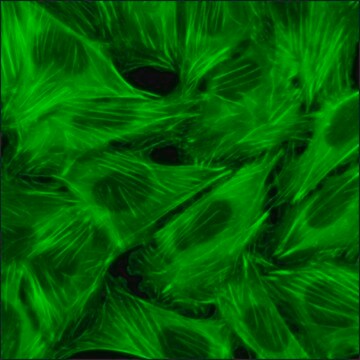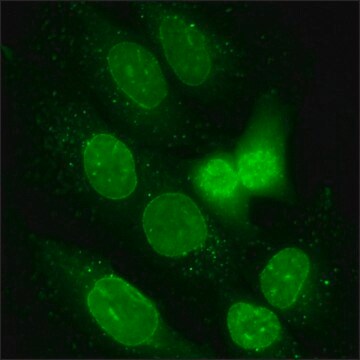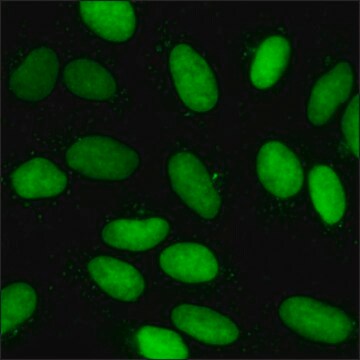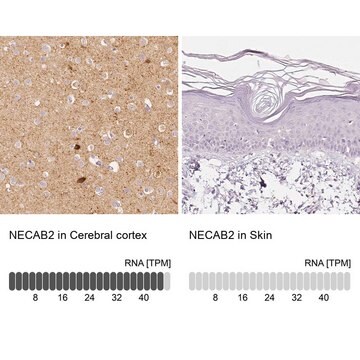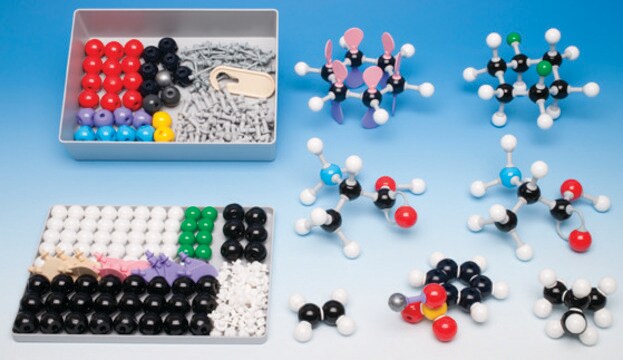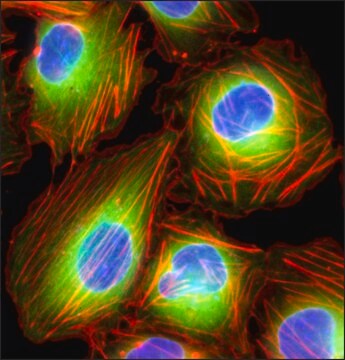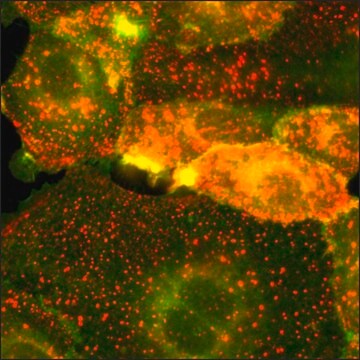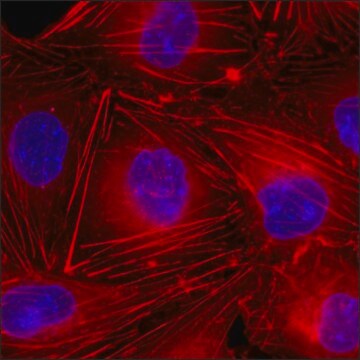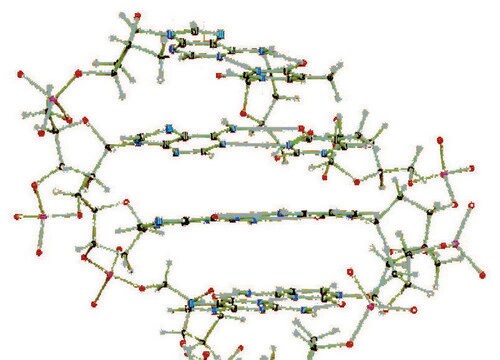CLL1037
U2OS GFP-ACTB RFP-TUBA1B
human female bone (Disease source: Osteosarcoma)
Se connecterpour consulter vos tarifs contractuels et ceux de votre entreprise/organisme
About This Item
Code UNSPSC :
41106514
Nomenclature NACRES :
NA.81
Produits recommandés
product name
U2OS GFP-ACTB RFP-TUBA1B,
Source biologique
human female bone (Source Disease: Osteosarcoma)
Température de stockage
−196°C
Informations sur le gène
human ... ACTB(60) , TUBA1B(10376)
Description générale
This product was derived from ATCC Cat. No. HTB-96.
U2OS GFP-ACTB RFP-TUBA1B are osteosarcoma, epithelial cells, from a human caucasian female (aged 15 years), with GFP-tagged and RFP-tagged modifications.
U2OS GFP-ACTB RFP-TUBA1B are osteosarcoma, epithelial cells, from a human caucasian female (aged 15 years), with GFP-tagged and RFP-tagged modifications.
Application
This product is a human U2OS cell line in which the genomic ACTB gene has been endogenously tagged with a Green Fluorescent Protein (GFP) gene and in which the genomic TUBA1B gene has been endogenously tagged with a Red Fluorescent Protein (RFP) gene using CompoZr® Zinc Finger Nuclease technology. Integration resulted in endogenous expression of a fusion protein in which GFP is attached to the N-terminus of actin and of a fusion protein in which RFP is attached to the N-terminus of tubulin. Fluorescence imaging shows that the actin can polymerize to form the characteristic pattern of actin filaments and that the tubulin can polymerize to form the characteristic pattern of microtubules. This stable cell line was expanded from a single clone. The target′s gene regulation and corresponding protein function are preserved in contrast to cell lines with overexpression via an exogenous promoter.
To learn more, please visit the Cellular Reporter Cell Line webpage
Actions biochimiques/physiologiques
TUBA1B (tubulin α 1b) is a microtubule protein, which has an important role in the dynamic process of polymerization and depolymerization during cell replication and division. TUBA1B is overexpressed in hepatocellular carcinoma (HCC) tumor tissues and proliferating cells. This upregulated expression of the gene leads to poor prognosis and chemotherapy resistance in HCC.
Actin β (ACTB) is an abundant cytoskeletal housekeeping protein. The protein is expressed in the nucleus and controls gene expression, cell division and proliferation. ACTB is generally used as a reference gene in measuring expression levels in tumors.
Actin β (ACTB) is an abundant cytoskeletal housekeeping protein. The protein is expressed in the nucleus and controls gene expression, cell division and proliferation. ACTB is generally used as a reference gene in measuring expression levels in tumors.
Tubulin α 1b (TUBA1B) is a microtubule protein, which plays a vital role in dynamic process of polymerization and depolymerization during cell replication and division. TUBA1B is overexpressed in hepatocellular carcinoma (HCC) tumor tissues and proliferating HCC cells. This upregulated expression of the gene leads to poor prognosis and chemotherapy resistance in HCC.
Actin β (ACTB) is an abundant cytoskeletal housekeeping protein. The protein is expressed in the nucleus and controls gene expression, cell division and proliferation. ACTB is generally used as a reference gene in measuring expression levels in tumors.
Actin β (ACTB) is an abundant cytoskeletal housekeeping protein. The protein is expressed in the nucleus and controls gene expression, cell division and proliferation. ACTB is generally used as a reference gene in measuring expression levels in tumors.
Caractéristiques et avantages
ACTB is GFP-tagged on chromosome 7p22.1 and TUBA1B is RFP-tagged on chromosome 12q13.12.
The U2OS cells are adherent, with a doubling time of approx. 29 hours.
The U2OS cells are adherent, with a doubling time of approx. 29 hours.
Composants
U2OS GFP-ACTB RFP-TUBA1B cells
Qualité
Tested for Mycoplasma, sterility, post-freeze viability, short terminal repeat (STR) analysis for cell line identification, PCR assay for cell line species confirmation.
Notes préparatoires
Media Renewal changes two to three times per week.
Rapidly thaw vial by gentle agitation in 37°C water bath (~2 minutes), keeping vial cap out of the water. Decontaminate with 70% ethanol, add 9 mL culture media and centrifuge 125 x g (5-7 minutes). Resuspend in complete culture media and incubate at 37°C in a 5% CO2 atmosphere.
Subculture Ratio: approx. 1:3-1:6
The base medium for this cell line is McCoy′s 5A1 Medium Modified, Cat. No. M9309. To make the complete growth medium, add the following components to the base medium: fetal bovine serum, Cat. No. F4135, to a final concentration of 10%.
The cell freezing medium is DMSO 1X (Cat. No. C6164).
Rapidly thaw vial by gentle agitation in 37°C water bath (~2 minutes), keeping vial cap out of the water. Decontaminate with 70% ethanol, add 9 mL culture media and centrifuge 125 x g (5-7 minutes). Resuspend in complete culture media and incubate at 37°C in a 5% CO2 atmosphere.
Subculture Ratio: approx. 1:3-1:6
The base medium for this cell line is McCoy′s 5A1 Medium Modified, Cat. No. M9309. To make the complete growth medium, add the following components to the base medium: fetal bovine serum, Cat. No. F4135, to a final concentration of 10%.
The cell freezing medium is DMSO 1X (Cat. No. C6164).
Informations légales
CompoZr is a registered trademark of Merck KGaA, Darmstadt, Germany
Clause de non-responsabilité
Ce produit, destiné à la recherche scientifique, est soumis à une réglementation spécifique en France, y compris pour les activités d'importation et d'exportation (Article L 1211-1 alinéa 2 du Code de la Santé Publique). L'acheteur (c'est-à-dire l'utilisateur final) est tenu d'obtenir une autorisation d'importation auprès du Ministère français de la Recherche, mentionné à l'article L1245-5-1 II du Code de la Santé Publique. En commandant ce produit, vous confirmez détenir l'autorisation d'importation requise.
Produit(s) apparenté(s)
Code de la classe de stockage
10 - Combustible liquids
Classe de danger pour l'eau (WGK)
WGK 3
Point d'éclair (°F)
188.6 °F - closed cup
Point d'éclair (°C)
87 °C - closed cup
Certificats d'analyse (COA)
Recherchez un Certificats d'analyse (COA) en saisissant le numéro de lot du produit. Les numéros de lot figurent sur l'étiquette du produit après les mots "Lot" ou "Batch".
Déjà en possession de ce produit ?
Retrouvez la documentation relative aux produits que vous avez récemment achetés dans la Bibliothèque de documents.
ACTB in cancer.
Guo C, et al.
Clinica Chimica Acta; International Journal of Clinical Chemistry, 417, 39-44 (2013)
Increased α-tubulin1b expression indicates poor prognosis and resistance to chemotherapy in hepatocellular carcinoma.
Lu C, et al.
Digestive Diseases and Sciences, 58(9), 2713-2720 (2013)
Up-regulation of TUBA1B promotes astrocyte proliferation after spinal cord injury in adult rats.
Liu Y, et al.
International Journal of Clinical and Experimental Pathology, 10(2), 1094-1103 (2017)
ACTB Loss-of-Function Mutations Result in a Pleiotropic Developmental Disorder.
Cuvertino S, et al.
American Journal of Human Genetics, 101(6), 1021-1033 (2017)
Notre équipe de scientifiques dispose d'une expérience dans tous les secteurs de la recherche, notamment en sciences de la vie, science des matériaux, synthèse chimique, chromatographie, analyse et dans de nombreux autres domaines..
Contacter notre Service technique